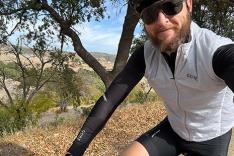
Below is an excerpt from the book "The No-Drop Zone: Everything You Need to Know About the Peloton, Your Gear, and Riding Strong" by Patrick Brady. The 250-page book outlines all aspects of road cycling for beginners, from riding skills to bike gear to the cycling lifestyle. Learn more about the book here.
Riding with clipless pedals is a lot like skateboarding with your feet duct-taped to the board. Clipless pedals take some getting used to, but once you feel comfortable "clipping in," you'll be amazed at how much more power goes directly to the bike.
The first thing you have to do is learn how to clip in and clip out. A stationary trainer that holds your bike steady while allowing you to pedal can be helpful. Alternatively, you can position your bike in a doorway and practice by backpedaling. Try pedaling for a minute, stop, turn your heel outward, and clip out. Each time, slide off your saddle and touch your foot to the ground before starting again. This practice will serve you well on the road.
The first place you'll see your increased efficiency is in starting from a standstill. New riders will frequently push off multiple times, with one foot kicking at the ground as if they were using a scooter. There's an easier way.
Clipping In
Clip your dominant foot into the pedal—we'll assume it's your left. Bring the pedal up to the 11 o'clock position. Now, rather than kicking off with your foot that is on the ground and trying to find purchase with a decidedly slippery cleat, push off slightly with your right foot while making a forceful pedal stroke down with your left foot. This will quickly generate enough momentum so you can pedal a few strokes and then clip in your right foot.
Clipping in your second foot should be done with that pedal positioned at 12 o'clock—the top of the pedal stroke, which means that the foot already clipped in will be at 6 o'clock—the bottom of the pedal stroke. This pressure on the opposite pedal will make clipping in easier.
Many pedal systems (such as Look, Time, and Shimano) work by hooking the front lip of the cleat into the pedal and stepping down to overcome the retention spring and lock the cleat in place. With these pedals, the rear of the pedal is weighted to keep the front of the pedal up and easy to catch with the cleat. To engage the cleat, start with the toe of the shoe behind the pedal and slide it forward across the pedal. The lip of the cleat should catch the pedal; begin the downstroke of the pedal and the cleat should engage.
Other pedal systems (e.g., Speedplay and Crank Brothers) work by simply stepping down on top of the pedal. With Speedplay and Crank Brothers pedals, just line the cleat up on top of the pedal and step down squarely.

No matter what pedal system you use, it's important to avoid looking down at your pedal when rolling out. Keep your head up and eyes forward so that you can avoid obstacles as well as other riders if you are on a group ride.
Clipping Out
When stopping, clip out your non-leading (or kicking) foot. Because your leading foot is the one you balance on when kicking a ball, leaving it clipped in will give you more control and balance when one foot is clipped out. Many new riders fall over as they ride up to stop lights the first few times because they are indecisive about which foot to clip out. If you know that you will always clip out your right foot, that moment of indecision at low speed will be eliminated.
The art of efficiently clipping in and out can sound a bit complicated, but remember, just like the steps involved in starting a car and pulling out of a parking spot, all those seemingly complicated steps become a fluid sequence after a few rides.
 Clipped in? Search for a cycling event.
Clipped in? Search for a cycling event.About the Author









Discuss This Article